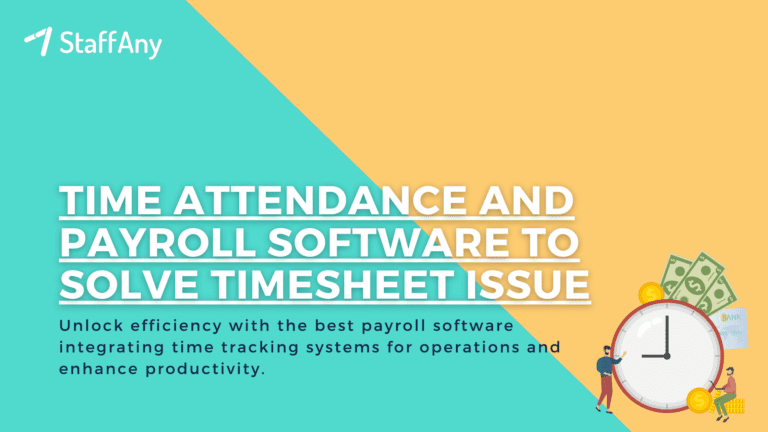Effective scheduling is a vital aspect of any business operation. From managing employee shifts to ensuring proper coverage, scheduling plays a crucial role in maintaining productivity and meeting customer demands. However, manual scheduling processes can be time-consuming, error-prone, and inefficient. This is where an automated scheduling system comes into the picture.
An automated scheduling system is a software solution designed to streamline and optimise the scheduling process, offering numerous benefits to businesses of all sizes and industries.
In this article, we will explore the 11 key benefits of an automated scheduling system and introduce StaffAny, a leading provider of comprehensive and user-friendly automated scheduling software.
Let’s dive in and discover how businesses can leverage the power of automation to enhance their scheduling processes and achieve operational excellence.
What is an Automated Scheduling System?

Managing schedules can be a daunting task for businesses of all sizes. Coordinating employee shifts, assigning tasks, and ensuring proper coverage can consume valuable time and resources. This is where an automated scheduling system comes into play.
An automatic scheduling system is a software solution designed to streamline and optimise the scheduling process. It eliminates the need for manual scheduling and provides numerous benefits to businesses.
Read more: 12 Critical Employee Scheduling Problems and How to Solve Them
How Does Automated Scheduling Work?
Automated scheduling, often facilitated by scheduling software or systems, works by using algorithms and predefined rules to assign tasks, appointments, or resources to specific time slots or individuals without manual intervention. Here’s a general overview of how automated scheduling works:
1. Data Input
The first step is to input relevant data into the scheduling system. This data may include details about tasks, appointments, resources, employees, constraints, and priorities. It can also include historical data and preferences if available.
2. Rules and Constraints
Automated scheduling systems operate based on a set of predefined rules and constraints. These rules can encompass various factors, such as employee availability, skill requirements, task priorities, and legal regulations. Constraints might include maximum working hours, mandatory breaks, and other scheduling restrictions.
3. Algorithmic Optimization
The scheduling software employs algorithms to optimize the allocation of tasks or resources. These algorithms consider the data, rules, and constraints to generate schedules that meet specific objectives. Common optimization techniques include linear programming, genetic algorithms, and simulated annealing.
4. Schedule Generation
The system generates a proposed schedule that assigns tasks, appointments, or resources to specific time slots and individuals. The schedule is created based on the criteria set in the rules and constraints.
5. Evaluation and Adjustment
The generated schedule is evaluated to ensure it complies with all rules and constraints and meets the defined objectives. If any violations or conflicts are detected, the system may automatically make adjustments to resolve them.
Read more: Find Out 8 Tips to Create a Good Staff Schedule
6. Communication and Notification
Once a final schedule is generated, the system can communicate it to relevant parties. This may involve sending notifications to employees, customers, or stakeholders, informing them of their assigned tasks or appointments.
7. Real-time Updates
In some cases, automated scheduling systems are capable of making real-time adjustments to schedules. For example, they can handle last-minute changes, employee call-offs, or new appointments by recalculating and optimizing the schedule on the fly.
8. Reporting and Analysis
These systems often provide reporting and analytics features, allowing users to review scheduling data, track performance, and make data-driven decisions. Managers can monitor key metrics, such as resource utilization, overtime costs, and customer service levels.
9. Integration
Automated scheduling systems can integrate with other software and systems, such as human resource management systems (HRMS), customer relationship management (CRM) platforms, and communication tools, to streamline the scheduling process and ensure consistency in data.
10. User Interaction
While the primary goal of automated scheduling is to reduce manual intervention, users can still interact with the system to set preferences, make manual adjustments, or override automated decisions when necessary.
Overall, automated scheduling systems leverage algorithms, data, and predefined rules to optimize the allocation of resources, tasks, or appointments. They are valuable in industries and contexts where scheduling complexity, efficiency, and accuracy are critical, such as healthcare, manufacturing, transportation, and service industries.
Read more: 8 Staff Schedule Management Tips for Business Owners
What are the Benefits of Automated Scheduling Systems?
Automated scheduling systems bring a wide range of benefits to businesses, revolutionising the way they manage their workforce and schedules. Let’s explore these benefits in detail and see how an automated scheduling system can transform the scheduling process for businesses of all types and sizes.
1. Enhanced Efficiency and Time Savings
Automated scheduling systems significantly reduce the time and effort required to create and manage schedules. Although scheduling manually may take only a few minutes, but over extended periods, it takes increasingly more time to do tasks.
With just a few clicks, managers can generate optimised schedules based on predefined rules, employee availability, and skill sets. This efficiency translates into substantial time savings, allowing managers to focus on other critical aspects of their operations.
2. Improved Employee Satisfaction and Engagement
An automated scheduling system empowers employees by giving them more control over their schedules. It allows them to request time off, swap shifts with colleagues, and schedule meetings, view their schedules in real-time. This level of transparency and flexibility leads to increased job satisfaction, better work-life balance, and improved overall engagement.
3. Minimised Human Error
Manual scheduling is prone to errors, such as double booking or understaffing. An automated scheduling system minimises these errors by applying predefined rules and constraints to ensure accurate scheduling. This reduces the risk of costly mistakes and helps maintain a smooth workflow.
4. Improved Communication and Collaboration
Automated scheduling systems offer centralised platforms where managers and employees can communicate and collaborate effectively. Important updates, shift changes, and notifications can be easily shared, ensuring that everyone stays informed and connected. This streamlined communication process fosters teamwork and minimises confusion.
5. Optimal Staff Allocation
With an automated scheduling system, businesses can optimise staff allocation based on demand fluctuations and workload variations. The software considers factors like employee availability, skills, and preferences, ensuring the right people are assigned to the right tasks at the right time. This results in efficient resource utilisation and improved productivity.
Read more: Understanding Manpower Planning and Its Importance in F&B
6. Compliance with Labor Laws and Regulations
Scheduling compliance can be a complex task, considering the various labour laws and regulations governing employee work hours, breaks, and overtime. Automated scheduling systems can enforce these rules automatically, preventing non-compliance issues and reducing the risk of penalties or legal disputes.
7. Real-Time Visibility
Automated scheduling systems provide real-time visibility into schedules, allowing managers to track employee attendance, monitor labour costs, and identify any gaps or issues. This transparency enables proactive decision-making and empowers managers to make data-driven adjustments to ensure optimal scheduling.
8. Cost Savings
By optimising staff allocation and minimising scheduling errors, automated scheduling systems contribute to significant cost savings. Businesses can avoid unnecessary overtime expenses, reduce overstaffing, and improve operational efficiency, ultimately leading to a positive impact on the bottom line.
9. Seamless Integration with Other Systems
Modern automated scheduling systems often offer seamless integration with other business systems such as payroll, HR, and timekeeping. This integration streamlines data transfer, eliminates duplicate entries, and simplifies administrative tasks, saving time and reducing manual errors.
10. Scalability and Adaptability
As businesses grow, their scheduling needs evolve. Automated scheduling systems are scalable and adaptable, capable of handling increased employee numbers, multiple locations, and complex scheduling requirements. This scalability ensures that the scheduling process remains efficient and effective, even as the business expands.
11. Enhanced Data Analytics and Insights
Automated scheduling systems generate valuable data and analytics that can be leveraged to gain insights into workforce performance, trends, and opportunities for improvement. These insights can drive informed decision-making and help businesses optimise their scheduling strategies for better efficiency and outcomes.
Read more: 10 Effective Strategies for Managing Diversity in the Workplace
StaffAny: One-Stop Automated Scheduling System
An automated scheduling system brings numerous benefits to businesses, ranging from enhanced efficiency and time savings to improved employee satisfaction and engagement.
By leveraging the power of automation, businesses can streamline their scheduling processes, reduce errors, improve communication, optimise resource allocation, and comply with labour laws.
When it comes to automated scheduling systems, StaffAny is a leading provider. With its user-friendly interface, powerful features, and robust functionality, StaffAny’s employee shift scheduling software offers businesses a one-stop solution for all their scheduling needs.
Whether you run a restaurant, retail store, healthcare facility, or any other service-based business, StaffAny can simplify and optimise your scheduling processes, resulting in significant time and cost savings. Take the first step towards simplified scheduling and watch your business thrive with StaffAny!











